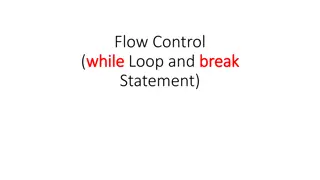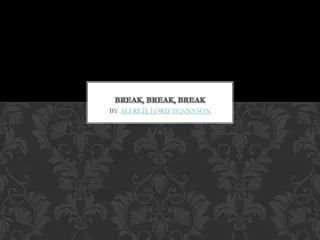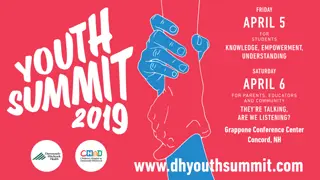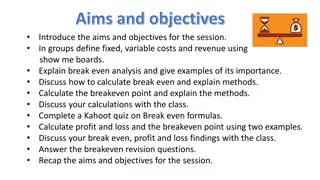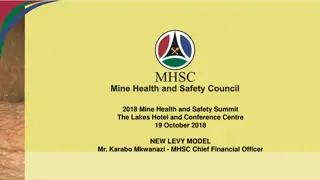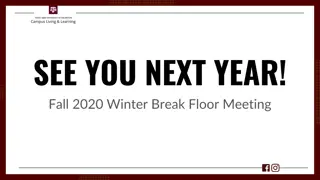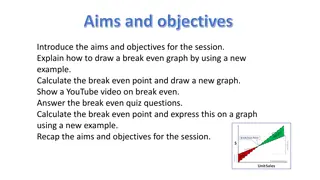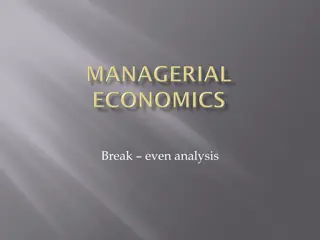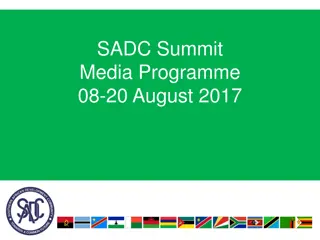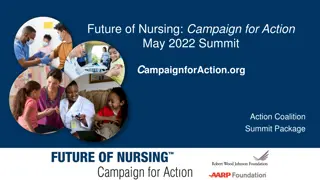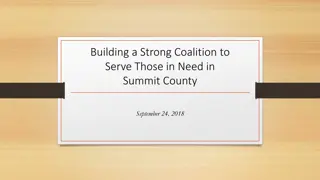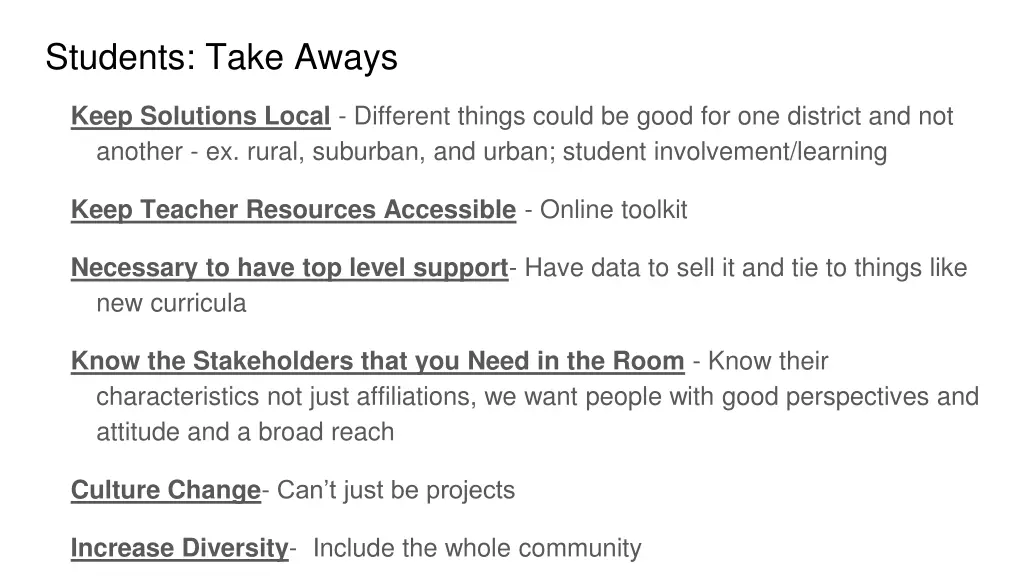
Empowering Students for Sustainable School Solutions
Explore strategies for student involvement, teacher support, stakeholder engagement, culture change, diversity, and sustainability in school initiatives. Address questions on curriculum integration, inclusiveness, sustainability coordinators, student voices, teacher awareness, and student engagement.
Download Presentation

Please find below an Image/Link to download the presentation.
The content on the website is provided AS IS for your information and personal use only. It may not be sold, licensed, or shared on other websites without obtaining consent from the author. If you encounter any issues during the download, it is possible that the publisher has removed the file from their server.
You are allowed to download the files provided on this website for personal or commercial use, subject to the condition that they are used lawfully. All files are the property of their respective owners.
The content on the website is provided AS IS for your information and personal use only. It may not be sold, licensed, or shared on other websites without obtaining consent from the author.
E N D
Presentation Transcript
Students: Take Aways Keep Solutions Local - Different things could be good for one district and not another - ex. rural, suburban, and urban; student involvement/learning Keep Teacher Resources Accessible - Online toolkit Necessary to have top level support- Have data to sell it and tie to things like new curricula Know the Stakeholders that you Need in the Room - Know their characteristics not just affiliations, we want people with good perspectives and attitude and a broad reach Culture Change- Can t just be projects Increase Diversity- Include the whole community
Students: Questions How do you merge curriculum instruction and facilities mgmt? How do you ensure that you are constantly open to increasing inclusiveness as your movement changes over time? How do you get a sustainability coordinator? How do you ensure that they understand what their role is (esp if they come from within the system)? How do you get the student voices included in the process from the beginning? How do you make sure that the teachers are aware of the broader benefits of their actions (e.g. giving up their microwave)?
Students: What does student engagement look like? They must be involved in green school transition process from the beginning (planning, implementation, and institutionalization) Participating in investigations, an integrated curriculum applicable to real world stewardship. Question: What happens when it is not possible to implement the project or the decision-makers turn you down? This is important for students to have a sense that they did something) An outcome of Student engagement is a sense of place and pride in place Moving beyond initiative to culture (ex. shift from recycling to be less wasteful, student leadership) Measurements
Students: What is needed to increase the likelihood of more/continued success? Bring in outside partners to help kids understand the why/how, and give a real world context by connecting to careers/dreams Maintain commitment to the project Teacher engagement and involvement PD, curriculum integration, administrative support/requirements Comprehensive approach to creating a new culture in a school system PD, dialogue, viewing green schools as a tool to achieve standards, etc. Problem-based kids like to solve real world problems that relate to them and their communities Partnership
Students: What is needed to increase the likelihood of more/continued success? Leadership at the top to create and support vision Create a Structure to perpetuate student, teacher, custodial, etc. engagement Student leadership show the students that you value their engagement Communicate to family and community to keep momentum going
Students (Tuesday discussion) More focus on students needed -- emphasis on student centered learning Opportunities to engage in national/regional convenings in DC area -- SC3 Summit @ NCTC; National Green Schools Conference Youth involvement in Bay Program - Youth Advisory Council Student participation in ELIT data review Green Schools Student Society
Students: How can federal/state agencies help? Funding: Funding for long term maintenance Look at other agencies to support school efforts: Dept of Energy grants to schools to increase efficiency, DoD (STEM $$), USDA, etc. Coordination of grants at state/fedl level to make it easier to navigate Leverage state funding streams that can easily support EL (21CCLC, MSP, etc.) Clearinghouse for sharing materials Incentives to schools to accept grants despite their current focus on tests PD expertise and interns Inclusive of permissive language in E.O.s and legislation to allow for sustainable schools
Facilities: Take Aways/Questions Constant Change- Lots of changes constantly underway across school systems - work with the system on sustainability changes/actions Focus on building the right team, even if it starts with one bold person! Gather data and metrics to measure impact Ownership- Everyone within the system (students to admin) need to own the effort Package & Provide Resources - Have existing resourced been packaged as a kit that could be provided to schools to enable their sustainability actions?
Facilities: What do effective partnerships look like? Responsive to the needs of the communities they serve Local & Need focused - School system level and focused on specific BMP s or needs (e.g. energy efficiency), others are statewide, regional (e.g. Green schools network) and may support or enable partnerships and work at the local level Communicate and Coordinate- Internal partnerships that ensure coordination and communication within and then make external partnerships and communication easier Diversity of Organizations- Include sustainable schools champions inside and outside of government agencies/school systems
Facilities: What does success look like and how do we increase it? It typically has a champion behind it Leverages existing funding to accomplish better, more sustainable results Does not have a scale - can start at many different levels -- school building, system, state; just important to start somewhere Success is real and tangible and should remain focus of the many meetings and collaboration that are part of the process When you don t have to hold special meetings about sustainability - a result of a culture/operations shift
Facilities: How can federal/state agencies help? Continue federal green ribbon school recognition program Incentivize sustainable practices and planning with existing federal/state funds for schools (e.g. USDA nutrition/diet $, school construction $, etc) explore legislative approaches to codify incentives, especially in construction establish fair school funding first (address inequities in school funding formulas) State leadership encouraging school facilities engagement in sustainable schools (e.g. someone from the state told me to come to this!) Standardize sustainable design and practices for facilities and construction
Facilities (Tuesday discussion) Students can participate @ multiple levels -- participate, add value, innovate Cookie cutter schools may not be successful because things can vary at every site for a variety of reasons -- ask students, schools, and communities what they need Need to include teachers in facilities so they know how to use them Don t recreate the wheel; lots out there to use EPA siting guidelines
Environment: Take Aways - Funding for coordinators- some sustainability coordinators have to self fund their positions - Reach Non-traditional Audiences- need to reach the outside of the choir and communicate with them in a non-threatening way - Bring all the players to the table as equals- all facets of school sustainability- Facilities, curriculum, students, nutrition, parents and administration should be at the same table with the same voice in regards to school sustainability - More communication and outreach on Cost Savings- Cost savings is impressive, why aren t more schools doing this?
Environment: Take Aways/Questions What other school audiences (superintendents, facilities manager,etc) care about sustainable schools? Are sustainable schools valued beyond those bought into the movement? What does it take for a school system to buy into a holistic sustainability plan and what are incentives to get that buy-in? What are incentives for schools or school divisions to seek recognition for their sustainability efforts? Does it matter to be recognized? Take away: some sustainability coordinators have to self fund their positions We have come a long way in EE and sustainability, but a lot to do to reach the non choir and communcate with them in a non threatening way Facilities, curriculum, students, nutrition, parents and administration should be horizontal i.e. at the same table with the same voice in regards to school
Environment: What do effective BMPs look like and what does success look like? - Includes the Youth Voice -student s must be involved and be able to articulate why the school is doing a BMP - Provides a model being replicated by other schools, local colleges, community partners - When it s expected- When it s a normal expectation for schools for all sectors (parents, facilities, food, teachers, school boards, administrators). - long-term and part of a systemic plan - Strategic Planning -have a strategy, plan,implementation, assessment, and part of sustainability is culture and behavior change
Environment: What do effective BMPs look like and what does success look like? assess with data such as pre and post test, assess impact on teachers, and community BMPs have creation, evaluation and reflection When it involves the entire system, it doesn t just impact on sector of sustainability, it should be holistic
Environment: What is needed to increase likelihood of success? Flat hierarchy and more voices at the table. Distributed ownership Targeted communication to stakeholders (including admin, school boards, parents, facilities) to demonstrate value of green schools Include students in outreach Use quantitative data, research and assessments to make the case as much as possible Include cost savings, student health, achievement Engage environmental managers (municipalities, state agencies, environmental NGOs) to see value of school for environmental BMPs Utilize the reality that schools are often the most public (and safe) institution in communities and places for community learning Campaign to make sustainability more sexy
Environment: How can federal/state agencies help? Funding Multi year funding (even if it s not a huge amount of money) Can we collectively go after a large pot of $ for a watershed wide initiative, CBFN is the entity who holds the grant Every EPA grant has a small percentage of $$ for school Don t break up pot of $, bring school divisions from each state that are high fliers and those on the cusp, do long term training and model dissemination Make it a focused topic of executive committee meeting Model sustainability at our own agencies (federal and state offices and practices). Sustainability should be a business model for fed, state, and county governments. We should be role models.
Environment (Tuesday discussion) What is the incentive to apply for awards? Not just about the leadership of school, but more about the students and custodians taking pride and ownership Lack of recognition is important -- principals who don t get the award want to know why they didn t get it and then go back and ask their staff Give students more information and data
Other Thoughts? (Monday closing session) - Keep the Green Ribbon Schools program and Env. Lit. workgroup going - How can we have this discussion in our own states? Keep the momentum going - How can we better tie Env. Lit. to the end goal of improving the health of the Bay (increase project based learning? Local learning?) - Connection to performance THANK YOU!!!!!
State Report Outs: Other Stuff Create a new column with bins in the spreadsheet
State Report Outs: Pennsylvania 1.establishing a green and healthy schools partnership- multi-stakeholder (states, NGO, Fed) Partnership recognizes using Eco-Schools as a way to achieve green ribbon 2. collaboration on a regular basis- streamline communications (responsibility of workgroup and new partnership) considering green cleaning law- building upon and improving on MD law - communication between the two states is happening (needs to be added as an action in the workplan)
State Report Outs: Maryland 1.need to develop a state level definition of sustainable schools - with a measurable goal attached State-wide policy to have each jurisdictions develop their own plans on sustainable schools - step one- meeting of superintendents, CPAC meeting 2. Chemical Cleanout program- some crossover with PA s program, develop a training program from PA model that could be used to train MD
State Report Outs: Delaware 1. fleshed out and made actions more detailed- has already modeled some of their actions after states with similar actions - maybe the next step is to set up a meeting with these model states Instead of making a new website, will link to partner resources 2.
State Report Outs: DC 1. annual meeting with healthy youth and schools commision (management approach 2) continuing progress on green and healthy schools certification process 2. could collaborate on strengthing ties with university partners
State Report Outs: West Virginia 1.not signed on but will look at the workplan, could put in non state gov actions 2.green ribbon schools
State Report Outs: Virginia 1.Management approach 1 - add more detail to performance target to green schools target- guidance doc for facilities playgrounds to playclassrooms - updating to current standards and research 2. similarities with playgrounds to playclassrooms and school grounds for learning Reaching out to lorna to supplement resources on the VA resource website
Regional Ideas Identify and (as needed) facilitate conversations of thought partners across states to collaborate on similar projects or among people with similar roles Continue to look for opportunities to work with 3rd party certification partners to build out continuum of opportunities for schools to pursue Collaborate on state level guides for schools that outline policies, programs, and strategies for sustainable schools based on current stds and research Share and exchange models for sustainable schools (from MD to regional?) regional level plan for the health component - maybe could be populated in school grounds for learning replicate this type of sustainable schools meeting in each state
Ideas for capacity building funding mentorship programs for school systems convening meetings for superintendents / state leadership sustainable schools kits sorted by state or rural / urban? states could apply for the projects that they need menu of options? Student Leadership programs explore opportunities for cross git collaboration

